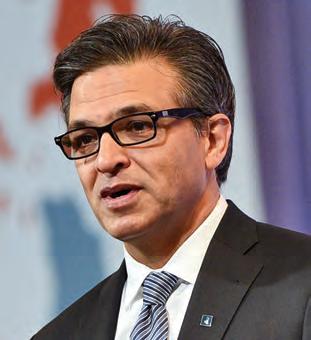
21 minute read
Langley’s Railway Crossing Information System 1
Flickr image courtesy B.C. government
closed and a detour route was designated via the Garner and Webster Lake Road system, which local ministry staff and a maintenance contractor ensure continues to provide access to the ?Esdilagh First Nation community, ranches, homes, logging activities and farming lands.
The ministry is finalizing a detailed design for the new road, which will bypass the active slide areas that were washed out. The work will include the construction of 5 km of a two-lane road on a new alignment, a new bridge crossing the creek and rock stabilization along the new route.
Upon completion of the final engineering design, the ministry will hold a public information session in spring 2020 to share it and the project timelines. At this point, construction is expected to begin in 2020 and finish by late 2022.
MUHC achieves second LEED Gold certification Montreal-based McGill University Health Centre’s (MUHC’s) Glen site has become the first hospital in Quebec to be twice certified to Leadership in Energy and Environmental Design (LEED) Gold.
The Canada Green Building Council (CaGBC) awarded the certification to the McGill Healthcare Infrastructure Group (MHIG), comprising SNC-Lavalin and Innisfree Canada, which designed, built and financed the complex as part of a public-private partnership (P3) and will operate it until 2044. The site opened in 2015 and obtained its first LEED Gold certification for new construction (NC) in 2016. This second certification is for existing buildings (EBs).
"MHIG is proud to have obtained LEED Gold EB certification," says Jean-Pierre Dumont, president of MHIG. "Thanks to the efforts of an accomplished team from Johnson Controls Quebec and SNC-Lavalin, we have succeeded in building a hospital complex that ranks among the greenest in North America."
The following are some the hospital’s measures that save energy and improve indoor air quality (IAQ): • Adapted fixtures that minimize light pollution and emphasize natural light. • Low-flow faucets that reduce potable water consumption by 40% in relation to comparable buildings. • Highly reflective materials mitigate the ‘heat island’ effect, as do green spaces with trees, perennials and shrubs that do not require watering.
MHIG reports these and other energyefficient initiatives have yielded savings of approximately $2.5 million per year.
8 www.canadianconsultingengineer.com March/April 2020 PEOPLE Exp Exp appointed Reece Bailey executive vicepresident (EVP) for major projects. He joins the firm from SNC-Lavalin and has more than 25 years’ experience in transit and rail design, operations, facilities and systems engineering. Reece Bailey
Stantec Stantec promoted Susan Walter, P.Eng., to executive vice-president (EVP) of infrastructure on a global basis. She has 35 years’ industry experience, began her career as a civil engineer in transportation and has worked for Stantec since it acquired Vollmer Associates in 2007. Susan Walter
Dillon Consulting Sean Hanlon is now CEO of Torontoh e a d q u a r t e r e d Dillon Consulting. Based in Saint John, N.B., Hanlon is a chemical engineer with more than 28 years’ industry experience. He joined Dillon in 2002, became a partner in 2007, began leading the environmental sciences group in 2014 and was appointed president in 2019 (after serving as interim president in 2018). Sean Hanlon
CHAIR’S MESSAGE
As ACEC member firms’ public and private sector clients are increasingly committed to achieving more sustainable solutions, and in light of the government’s environmental objectives, ACEC made the following recommendations within its submission for the PreBudget Consultations in advance of the 2020 Budget. In addition to improving the social and economic quality of life for Canadians, these recommendations show how the consulting engineering sector is part of efforts to mitigate and adapt to climate change while highlighting the role consulting engineers play in achieving these goals.
Infrastructure can be an effective investment in our social, economic and environmental quality of life. However, priority should be given to core infrastructure that grows the economy making further investments in community, social and environmental infrastructure viable and sustainable. Projects conceived of and designed by the consulting engineering industry can have a direct impact on climate change and all aspects of sustainability. This means that consulting engineering firms and their clients are in a position to influence mitigation (reduction in greenhouse gas release), and resilience (reduction in impact of more extreme climate conditions on human habitats).
There are a number of available approaches to mitigation and resilience with new engineering projects. Adaptation to the realities of climate change brings a different kind of engineering problem. New designs must now rely on climate prediction rather than history, which to date is a much less certain and specific basis for design. As a result, new projects will require greater factors of safety to achieve the same security and the projects will be more expensive and potentially carry more risk than those in the past. A bigger challenge is the large stock of past projects that will require creativity and ingenuity to reduce emissions or to improve resilience to the environment.
To combat climate change and be at the forefront of innovation, much of which is centered around green technology and infrastructure, confidence in consistent ongoing investment is essential. Both the Investing in Canada Plan and the Building Canada Plan are significantly backend loaded, with most of the investments skewed toward the latter years of the program. To allow vital infrastructure investments to have positive economic and environmental impacts in a timelier and more consistent manner, we recommended that the delivery of already-committed infrastructure funds and projects be expedited through a forward re-profiling of the existing Building Canada Plan, and that the planning and renegotiating of the next generation of federal infrastructure investments occur prior to the expiry of current programs.
Infrastructure projects do not exist in isolation of one another. Collectively, our infrastructure is what connects and enhances communities, enables commerce and trade, and protects our environment, but is only as effective as the weakest link. Therefore, to receive the best return on investment and most effectively address climate change, a coordinated and strategic approach should be taken to infrastructure planning and investment. In cases where municipalities have robust and well-considered asset management plans, ACEC recommends providing funding based on their investment program rather than on a project-by-project basis. This approach would allow multiple strategicallyrelated projects to be efficiently approved under a single application and would serve as an incentive for municipalities to develop and adopt asset management plans to guide strategic investment decisions.
ACEC also urges the government to enact many of the recommendations from the 2017 Senate Report titled National Corridor: Enhancing and Facilitating Commerce and Internal Trade written by the Senate Committee on Banking, Trade and Commerce. Establishing the concept of such a corridor, which is in effect a pre-established, preapproved right-of-way dedicated to accommodating multiple infrastructure assets (e.g. road, rail, pipeline, electrical transmission and communication), would require smaller geographical footprints and result in less impact on the environment and on surrounding land uses. This implementation would proactively address social and environmental concerns making the planning, development and implementation of both public and private infrastructure projects less costly and more time effective. A national corridor would help bring projects to fruition and limit the environmental impacts, both of which are in support of the government’s objectives. However, because of the national scope of such a project and the many jurisdictions and stakeholders involved, national leadership is required from the government.
LAWRENCE LUKEY, P.ENG. CHAIR, BOARD OF DIRECTORS, ACEC – CANADA ACEC recommendations to combat climate change ahead of 2020 Federal Budget
IN DISCUSSION with

In Discussion with ACEC is a series of informal conversations between ACEC-Canada and government decision makers and business leaders. This edition is with Goldy Hyder, President and CEO of the Business Council of Canada, a not-for-profit, nonpartisan organization whose mission is to make Canada the best place in the world in which to live, work, invest and grow. Representing 150 chief executives and entrepreneurs from businesses in every region and sector of the country, its member companies employ 1.7 million Canadians, contribute the largest share of federal corporate taxes, and are responsible for most of Canada’s exports, corporate philanthropy, and private-sector investments in research and development.
During your keynote address at our conference last fall, you expressed concern for Canada’s competitiveness and our economy’s rank amongst other G7 and emerging nations. The Council’s report A Better Future for Canadians offers several recommendations to address this issue. Which do you believe our government should address first? My main message to ACEC’s leadership conference last fall was that Canadians should be proud of what we’ve achieved over the past 150-plus years. For example, we continuously rank first in the world when it comes to quality of life. However, we cannot take our past success for granted. As we enter the 2020s, I strongly believe that we need an honest conversation about the challenges we face in the decade ahead and what kind of country we are leaving behind.
Whenever I talk to the members of the Business Council, they tell me that their number one motivation is what kind of opportunities await their children, grandchildren and future generations of Canadians. They know of no other way to improve lives and take on the challenges we face – from climate change to the impact of an aging population – than to grow our economy. That is why we launched the Task Force on Canada’s Economic Future as a collaborative process engaging diverse groups of stakeholders and to hear from Canadians from all regions, walks of life and backgrounds. Our findings, which were published in our report A better future for Canadians, identify six specific, practical and achievable recommendations that Canada’s government can implement to accelerate the pace of economic growth.
In our view, regulatory modernization has the greatest potential to improve the lives of citizens, drive innovation and enhance business activity across the board. Again and again during our consultations, participants cited inefficient regulation as the single greatest obstacle to Canadian competitiveness and economic growth. In fact, on the same week that I addressed ACEC’s leadership conference, the World Bank downgraded Canada from 22nd to 23rd in its Ease of Doing Business index. This drop of just one spot may seem small, but it is especially disconcerting when you consider that Canada ranked fourth in the world less than 15 years ago in 2006.
Every government pays lip service to red-tape reduction, and now and then there are moves in the right direction. Yet the regulatory environment continues to increase in both complex
10 www.canadianconsultingengineer.com March/April 2020 ity and unpredictability, creating unnecessary barriers to innovation and growth. It is time for a new approach. We’re calling on Canada to commit to becoming the most efficiently regulated country on earth. We’re proposing an independent, arm’s-length oversight agency similar to ones in Germany and Denmark that works to improve the transparency and accountability of the regulatory system while reducing the regulatory burden on businesses and citizens.
You also spoke during your address for the need to “figure out” energy, the environment and infrastructure. Why is investing in infrastructure so critical to our natural resource sector and the environment? A country’s productivity and prosperity are closely tied to its infrastructure—a fact that can be observed in any country you visit. This is particularly true for Canada, with its vast size and dependence on international trade, yet Canada lags its international peers in quality of trade and transportation infrastructure. The World Bank ranks Canada 21st in the world based on the quality of trade and transportation infrastructure, such as ports, railroads and highways. Germany is in first place and the United States is in seventh.
I always remind audiences that the Business Council of Canada was the very first business organization in North America to endorse carbon pricing. We’re already on board with the environmental agenda. We’ve got lots of people talking about that, but we better figure out how to make sure that we’re building the infrastructure for
our resources right across this country. While we support the new Canada Infrastructure Bank, our Task Force report proposes the adoption of a more methodical, transparent and strategic process for prioritizing major infrastructure projects. The easiest way to do that would be to borrow from Australia the model of an independent, non-partisan body to provide independent research and advice to all levels of government as well as to investors and owners of nationally significant infrastructure.
ACEC has long advocated for a national infrastructure corridor which would permit proponents of major projects to build assets in an environment with more regulatory certainty. Would you agree that this nation building idea would help us remain competitive on the global economic stage? That’s a very good question and I am so glad to hear that this is a priority for ACEC and its members.
Blessed with the incomparable advantage that our resource bounty represents, most other countries would have long ago developed a national vision of how to responsibly develop the products and technologies that the world needs. Yet the situation in Canada has been marked by polarization and paralysis by analysis. Complex approval processes, long wait times and the ever-present threat of court challenges have resulted in declining investment in key sectors, as both domestic and international firms seek out a more welcoming investment environment in other countries.

What too often gets lost in the debate is the extent to which our industries already are addressing the key challenges. Oil sands companies are spending billions to address GHG emissions. They have also chosen to forego intellectual property rights in order to share newly developed technologies that reduce environmental impact. We need a way forward and a vision that unites the country and finds common ground.
A key focus should be on the infrastructure the country requires to bring this vision to reality, including oil, gas and electricity transmission, rail, roads, ports and related transportation infrastructure. The goal should be to ensure that all regions realize added benefit from Canada’s resource wealth, in part by expanding access to global markets so that Canadians get full value for their resources. That is why the Task Force report calls on the federal government to develop a national resource strategy in collaboration with the provinces. The goal should be to strengthen Canada as a location of choice for leading-edge resource companies that demonstrate how to achieve superior economic and environmental performance.
You’ve stated that building the economy is not solely the responsibility of government but of business as well. What are the top 3 things businesses can do to step-up to the plate? This is something I strongly believe and every day it is becoming a more important topic.
In January, I attended the World Economic Forum in Davos where all Goldy Hyder

the talk was about defining the purpose of corporations. I am glad to report that Canadian businesses have long led the way. In fact, the goal of improving life for all Canadians goes back to the Business Council’s founding in 1976. More than 20 years ago we established our motto of “making Canada the best country in the world in which to live, work, invest and grow.” But as our report notes, ensuring a better future for Canadians is not just the responsibility of government. Business has to step up, too. As employers of nearly 2 million Canadians and as prominent leaders of the wider business community, our members identified six areas where they strongly felt they could have a meaningful impact on the lives of all Canadians.
Three of these commitments have been prioritized, including gender and diversity, mental health and Indigenous engagement. In each of these areas, we’ve either established CEOled working groups to chart a path forward or developed protocols for our members to lead by example.
In the end, our goal is to broaden the tent and work with governments and other key stakeholders like the ACEC. Because here’s the thing, we are the first generation in Canada’s history who are not on track to provide our children and grandchildren with a better standard of living than the one we enjoyed. That alone should motivate us in the decade ahead.

BST Global provides integrated enterprise resource planning (ERP) and work management solutions for the world’s leading architects, engineers, and environmental consultants (AEC). More than 100,000 professionals across six continents and 65 countries rely on BST software solutions each day to manage their projects, resources, finances, and client relationships. The company’s latest offering, BST10, is the world’s first multi-lingual business management system to be built exclusively for the AEC industry and made available both in the Cloud and On-Premises. Deployable as a comprehensive ERP or Work Management solution that integrates with your existing systems, BST10 is designed to help you create, manage, and share project and business tasks faster than ever before. BST10 Enterprise Realize your business goals sooner with BST10 Enterprise. Available in the Cloud or On-Premises, our robust ERP solution covers the entire project lifecycle, from bidding work to managing your projects and resources to accounting for your financials – all in one system. BST10 Work Management Take command of your projects, resources, and business opportunities with improved visibility from BST10 Work Management (WM). Our WM solution can connect to your existing financial solution, allowing you to Leading ERP and Work Management Software Solutions for the AEC Industry
leverage the strong project management capabilities of BST10, while still managing financials in your existing system.
BST10 Professional BST10 Professional is a no-frills, cloudbased ERP solution. Drive growth with an industry-focused ERP solution that equips emerging consultancies with the project management tools they need right out of the box – giving firms everything they need, and nothing they don’t.
The 1% rule is particularly problematic for consultants. JOINT & SEVERAL LIABILITY FOR ENGINEERS

Construction litigation involving engineers has become more common, but also more complex. One example of this trend, which can be particularly problematic, is the rule of joint and several liability. This rule can encourage a ‘shotgun’ approach to litigation, give rise to frivolous claims and result in disproportionate settlements. While the potential unfairness arising from the application of the rule has been recognized and debated, no legislative reform has yet been implemented in Canada. By Karen L. Weslowski
What is the rule? Also known by some as ‘the 1% rule,’ the rule of joint and several liability is a common-law principle, whereby each of those who have combined to cause a single, indivisible loss is liable to the injured person for the full amount of the damage suffered. Thus, a defendant who is found to be only 1% at fault can be obliged to pay the plaintiff’s entire judgment.
The underlying policy rationale is to ensure an injured plaintiff is made whole. The at-fault defendants, who may have paid the plaintiff’s damages disproportionately, can seek contribution and indemnity between themselves.
The rule has been codified into statute in every Canadian province and territory except for Quebec and Prince Edward Island. (In British Columbia, the rule does not apply where a plaintiff is held to be contributorily negligent, as this severs the liability.)
Construction projects commonly give rise to joint and several liability. Due to the nature of construction, the parties involved are generally considered several, concurrent tortfeasors, i.e. their separate acts combine to cause the same damage to the plaintiff. As a result, the named defendants in a claim often include every party involved in the construction project, including the developer, general contractor, project manager, consultants, contractors and sub-contractors.
While consulting engineers generally hold professional liability insurance, developers, general contractors, contractors and sub-contractors are often uninsured, underinsured or lacking in assets.

The problem for consulting engineers Consultants generally hold professional liability insurance, as a result of the terms of their retainer, the requirements of the authority having jurisdiction (AHJ) or the conditions of their membership with a professional regulatory association. Conversely, developers, general contractors, contractors and sub-contractors are often uninsured, underinsured or lacking in assets.
Joint and several liability can create unfairness for consultants when a claim relates to faulty workmanship, the liability for which should be apportioned primarily to the construction group. This often becomes evident at mediations.
In this situation, the engineer might have limited liability exposure for negligence in field review of the faulty workmanship; however, if the construction group lacks sufficient insurance or assets to pay the plaintiff’s claim, the rule of joint and several liability is often raised against the ‘deep-pocketed’ (i.e. insured) engineer to encourage a settlement contribution in an amount disproportionate to the engineer’s actual liability exposure. The engineer and/or its insurer may agree to the settlement to avoid incurring trial costs, a potentially unpredictable trial result and the potential for joint and several liability following trial.
The rule can also affect an engineer’s insurance premiums and claims history. It encourages plaintiffs to cast a wide net, such that engineers may be named in claims where they are not ‘target’ defendants, but rather peripheral defendants, included out of an abundance of caution or to provide an additional source of funds for settlement contribution at mediation. While the engineer may have a strong defence, the mere fact of being named as a defendant in an action can result in significantly increased insurance premiums and deductibles.
Rule reform The fairness and application of the joint and several liability rule have both been subject to recent debate in Canada.
Saskatchewan’s government amended its Contributory Negligence Act in 2004 to adopt a modified version of proportionate liability that applies in cases where the plaintiff is contributorily negligent and there is an unfunded liability (i.e. no assets or insurance to pay the plaintiff’s damages). In these cases, the cost of the unfunded liability is split among the remaining defendants and the plaintiff, in proportion to their fault.
Last year, Ontario’s government began consultations with lawyers, insurers and other stakeholders to determine how to make the joint and several liability provisions of its Negligence Act more fair as they relate to insurance costs and public services. In its submissions, the Association of Municipalities of Ontario (AMO) recommended the adoption of a full proportionate liability model—i.e. limiting the liability of each defendant to the proportion of loss for which they are found responsible.
AMO’s submissions were based on the following considerations:
Fairness It is unfair for a defendant whose degree of fault is minor when compared to that of other defendants to have to fully compensate a plaintiff should those other defendants be insolvent or unavailable.
Deep pocket syndrome Joint and several liability encourages plaintiffs to unfairly target defendants who are known or perceived to be insured or solvent.
Rising costs Opponents of joint and several liability are concerned about the rising costs of litigation, insurance and damage awards.
Provision of services Application of the joint and several liability rule could cause municipalities to delay or otherwise cut back services to limit exposure to liability. These factors have clear application to claims involving engineers. Worries about joint and several liability could lead to them either (a) turning down projects for fear of the rule’s application or (b) working without professional liability insurance.
What to do For engineers, the difficulty with joint and several liability is its general application to most construction projects. Even with a strong defence, when there is a 1% liability risk, an engineer’s exposure to the plaintiff’s damages could be considerably greater if the co-defendants are uninsured or lack assets. British Columbia’s exception often has limited application because the plaintiff may be a post-construction purchaser or strata corporation that had no role in the construction process and no real potential for contributory negligence.
Opting not to obtain professional liability insurance, so as to avoid becoming a ‘deep-pocketed’ target, is not a recommended option. Foregoing insurance may constitute a breach of the conditions of professional registration (i.e. in jurisdictions where insurance is mandatory) and exposes the engineer to personal liability.
There are limited strategies available to engineers to avoid the application of the rule. In British Columbia, the engineer’s defence should include the active pursuit of a contributory negligence argument, if available on the facts of the case. In other jurisdictions, at the start of projects, engineers could seek a contractual indemnity from their clients regarding potential future payments pursuant to the joint and several liability rule; however, this may be difficult to negotiate. Another step would be to ensure, if possible, all other parties involved in construction—particularly developers and contractors—hold sufficient insurance.
Ultimately, the best option for engineers who are concerned about unfairness resulting from the rule may be to contribute to the process of legislative reform. CCE
Karen L. Weslowski is a partner in the Vancouver office of Miller Thomson LLP, with an insurance defence practice focusing on professional liability and construction claims.
WE UNDERSTAND THE MECHANICS OF INSURANCE

As one of the largest independent insurance practices in the country, Miller Thomson’s Insurance and Risk Management group recognizes the need to assess, manage and deal with risk effectively. Our experienced lawyers have an in-depth knowledge of the construction sector and handle a variety of insurance litigation matters for a number of insurance carriers. We regularly represent clients in all areas of professional negligence defence as well as representing insurers in defence of errors and omissions claims against architects, engineers and construction contractors. With a presence in many of Canada’s major markets, the size and scope of our team means that we can provide creative, proactive and cost-effective advice specifically tailored to meet your needs. Visit our website to learn more.
FORWARD TOGETHER TM
MILLERTHOMSON.COM





